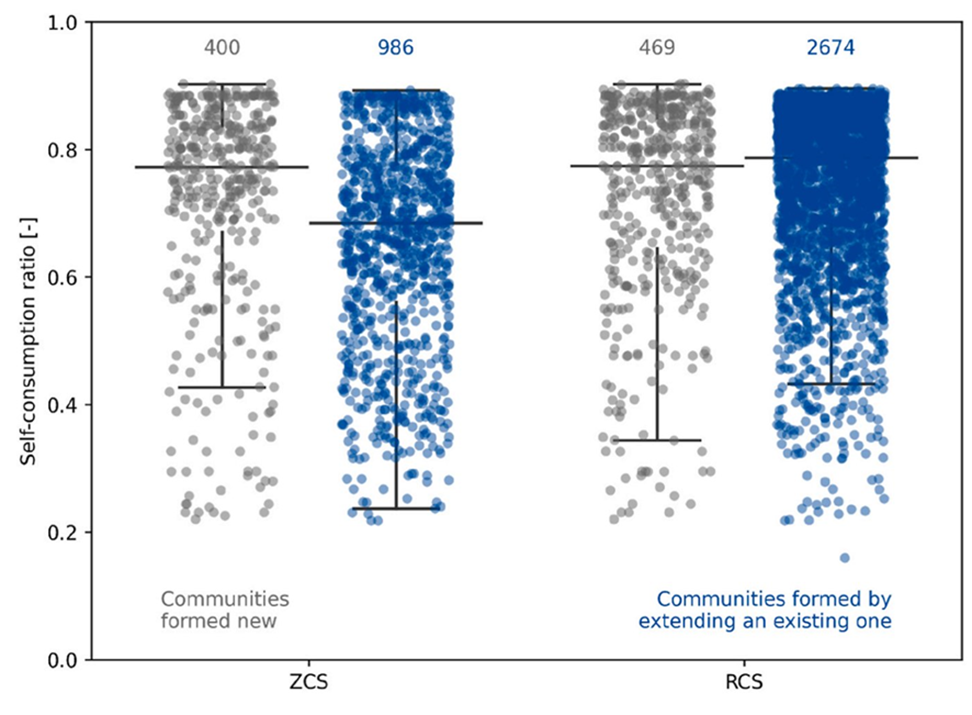
Should policymakers promote community solar PV systems in cities?
On 31.05.2023 by Danielle Griego, Prakhar Mehta, Alejandro Nunez-MartinezBy Danielle Griego, Prakhar Mehta, and Alejandro Nunez-Martinez
Danielle Griego is the Executive Director of Design++, the center for augmented computational design in architecture, engineering, and construction at ETH Zurich. Danielle completed her doctorate at ETH Zurich on the topic of integrating community solar into cities with a focus on participant driven approaches (via mobile apps) to facilitate intelligent energy utilization.
Prakhar Mehta is a PhD candidate at the Bits to Energy Lab Nuremberg. He has a background in energy and electrical engineering. In his PhD, he focuses on solar energy communities and demand response from electric vehicles.
Alejandro Nuñez-Jimenez is a Senior Researcher at the Group for Sustainability and Technology at ETH Zurich and an Associate at the Harvard Kennedy School. Alejandro completed his doctorate at ETH Zurich on policies for the diffusion of solar photovoltaics. His current research focuses on innovation policies for renewable hydrogen.
Community solar systems, defined as medium to large-scale PV installations co-owned by multiple building owners and/or tenants, offer one option to increase PV adoption in cities. This blogpost summarizes the findings of our recent paper that explores if, by how much and under which conditions community solar could help accelerate PV adoption in cities.
Opportunities and challenges for solar PV in urban areas
Cities are home to the majority of the world’s population. It is no surprise that cities consume nearly 70% of global energy and account for a similar percentage of CO2 emissions. Decarbonizing urban energy supply is, therefore, central to the energy transition and critical for addressing climate change.
Decentralized PV has short permitting times, can be installed physically closer to the end user and benefit from ‘self-consumption’, solar-generated electricity consumed on-site by households, businesses, or schools, connected to the installation. Also, thanks to the drastic fall in the cost of solar PV, and a large difference between retail and feed-in tariffs, self-consumed electricity is often cheaper than electricity from the grid.
Despite the advantages of decentralized PV, they remain rare in cities due to limited space, economic unattractiveness, and limited self-consumption for individual systems.
A growing trend in community solar, why the hype?
Community solar PV installations could help overcome the challenges of individual decentralized PV systems. Community solar systems are defined as medium to large-scale PV installations co-owned by multiple building owners and/or tenants who are physically connected to the system and who recover the cost of the investment by self-consuming the electricity from their shared rooftop PV system.
Over the last two decades, community solar installations have started to appear throughout Europe, the USA, and beyond. Their appeal includes greater economies of scale compared to individual rooftop systems, and increased self-consumption by aggregating the electricity demands of several buildings, which in turn reduces the amount of electricity fed to the grid and makes the project more cost-effective.
Policies fostering community PV installations
Despite the growing trend in community solar, there are only a handful of policies for community solar implemented around the world. Switzerland introduced a policy in 2018 to support groups of buildings that jointly invest in a community PV system. This policy, referred to as Zusammenschlüsse zum Eigenverbrauch (ZEV), means that the group of buildings have a single connection point to the electric grid.
How big should solar communities be?
The ideal size for solar communities is debated. On the one hand, smaller communities bring the advantage of easier collaboration between members to set up the community in the first place, and reduced overheads due to wiring and smart metering. On the other hand, larger systems allow economies of scale and often achieve better technical performance. In Switzerland, the policy has changed over time to promote larger installations by allowing buildings to form community PV even if they cross physical land boundaries (roads, rivers, etc.). However, since communities in Switzerland must build their own distribution grid and metering infrastructure, larger systems are perceived as being prohibitively expensive.
Should policy promote larger or smaller community PV installations?
We took it upon ourselves to investigate this question in a recent paper. For this, we developed an agent-based model and coupled it with an urban energy model (using City Energy Analyst), to simulate the decision-making process of nearly 5000 building owners to install solar PV in a city district in Zurich. The model also considered economic parameters to evaluate the benefits of economies of scale (investment costs of the PV system, costs to install additional cabling in cities, and regional electricity costs).
Using this model, we developed three scenarios:
- Individual (IND): the baseline where only individual PV installations are allowed
- Zone community solar (ZCS): where only buildings within the same block (‘zone’, enclosed by roads or rivers) can form a solar community
- Radius community solar (RCS): where all buildings within a 100 meter radius can form a solar community, even if they cross roads, rivers, etc.
Streets and land barriers do NOT limit community solar adoption
The results in Figure 1 show that policies allowing community solar installations to cross streets and land barriers (RCS, right panel) can actually improve overall solar PV adoption by up to 21% compared to the baseline (IND, left panel) – economies of scale drown out increased costs for laying additional cables. On the other hand, if solar communities can only form with adjacent buildings in their predefined zones (ZCS, middle panel), the overall installed PV capacity only increases by a modest 1% compared to the baseline (IND, central panel).

Figure 1: Solar PV deployment from 2010 to 2035 for each of the three scenarios: IND, ZCS RCS. Lines indicate median PV deployment and the shaded areas indicate 90% confidence intervals around the median.
Why does allowing larger solar communities increase adoption?
Our study shows that it is not (only) about the cost of installing the community’s own grid. A more permissive policy, allowing communities to form with any combination of buildings within a 100-meter radius, increases the diversity of buildings who can join a solar community. As a result of more diverse electricity demand profiles, self-consumption increases, and the projects are more economically attractive.
There are other advantages. We also consider the number of building owners who might learn about and become interested in joining or forming a solar community. Larger communities therefore increase the number of building owners who might consider installing PV – observing neighbors and peers installing PV “motivates” building owners – and therefore increases the number of installed PV systems when they are economically profitable.
Policies should allow solar communities to grow over time
Our simulations also show the importance of allowing communities to grow over time. Figure 2 illustrates that when allowed, there are more options for communities to grow over time for larger communities as shown in the radius community solar scenario (RCS). Figure 2 also shows that in addition to the increased number of buildings participating in solar communities, they also increase self-consumption from the shared PV system.

Figure 2: Self-consumption ratio for newly formed communities (grey) and for extended communities (blue) for the two community solar scenarios: ZCS and RCS.
Take-home messages
These findings demonstrate the potential for community solar to accelerate PV adoption in cities and underscore the significant role of policy design. Core messages of our study include:
- Solar PV adoption in Swiss cities can accelerate if policies allow and promote large community solar installations.
- The formation of larger energy communities helps overcome the cost of connecting to the distribution grid
- More flexible policies to encourage diverse buildings to form solar communities and enjoy the economic benefits of improved solar PV self-consumption.
- Policies should facilitate the formation of new solar communities and also make it easier for them to grow over time by adding new members.
Cover photo by Adobe Stock Images
Keep up with the Energy Blog @ ETH Zurich on Twitter @eth_energy_blog.
Suggested citation: Griego, Danielle; Metha, Prakhar; Nunez-Jimenez, Alejandro. “Should policymakers promote community solar PV systems in cities?”, Energy Blog @ ETH Zurich, ETH Zurich, September 23, 2022, https://blogs.ethz.ch/energy/solar-PV-community/
If you are part of ETH Zurich, we invite you to contribute with your findings and your opinions to make this space a dynamic and relevant outlet for energy insights and debates. Find out how you can contribute and contact the editorial team here to pitch an article idea!




The direct use of solar radiation to produce electricity or heat(!) is the only renewable energy resource with a usable potential that exceeds not only today’s energy consumption, but also the future demand including the required catching up by developing and emerging countries.
There are sufficient areas available in Switzerland for the use of solar energy. But still, their amount is not so redundant that we could afford to leave a considerable part unused. So, the short answer to the headline must be: Of course, policymakers should promote community solar PV systems in cities! As well as in any other appropriate area. If we want to run in front of the disastrous man-made climate change and not behind it, as many solar energy systems must be installed in parallel as possible.